
An evolution of the 1964 DOHC prototype “XJ13” engine, the Jaguar V12 engine is a family of SOHC internal combustion V12 engines with a common block design, that were mass-produced by Jaguar Cars for a quarter of a century, from 1971 to 1997, mostly as 5.3‑litres, but later also as 6‑litres, and 7‑litre versions that were deployed in racing. Except for a few low-volume exotic sports car makers, Jaguar's V12 engine was the world's first V12 engine in mass-production. For 17 years, Jaguar was the only company in the world consistently producing luxury four-door saloons with a V12 engine. The V12 powered all three series of the original Jaguar XJ luxury saloons, as well as its second generation XJ40 and X305 successors.

The Jaguar XJ-S is a luxury grand tourer manufactured and marketed by British car manufacturer Jaguar Cars from 1975 to 1996, in coupé, fixed-profile and full convertible bodystyles. There were three distinct iterations, with a final production total of 115,413 units over 20 years and seven months.

The Jaguar XJ220 is a two-seat sports car produced by British luxury car manufacturer Jaguar from 1992 until 1994, in collaboration with the specialist automotive and race engineering company Tom Walkinshaw Racing. The XJ220 recorded a top speed of 217 mph (349 km/h) during testing by Jaguar at the Nardo test track in Italy. This made it the fastest production car from 1992 to 1993. According to Jaguar, an XJ220 prototype managed a Nürburgring lap time of 7:46.36 in 1991 which was faster than any production car lap time before it.
Tom Walkinshaw Racing (TWR) was a motor racing team and engineering firm founded in 1976, in Kidlington, near Oxford, England, by touring car racer Tom Walkinshaw.

Joest Racing is a German sports car racing team that was established in 1978 by former Porsche works racer Reinhold Joest. Their headquarters are in Wald-Michelbach, Germany.

The Jaguar XJR-14 is a sports-prototype racing car introduced for the 1991 World Sportscar Championship season. It was designed by Ross Brawn and John Piper, and was built and run by Tom Walkinshaw Racing (TWR), on behalf of Jaguar Cars.

The Jaguar XJR sportscars were a series of race cars used by Jaguar-backed teams in both the World Sportscar Championship (WSC) Group C and the IMSA Camel GTP series between 1984 and 1993.
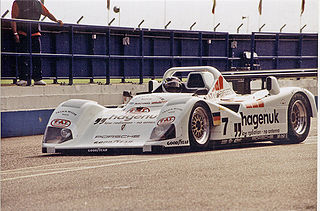
The Porsche WSC-95 was a Le Mans Prototype originally built by Tom Walkinshaw Racing. It was modified by Porsche from the original Group C Jaguar XJR-14 from which it derived, and run by Joest Racing. Originally intended to race in the IMSA World Sportscar Championship, the WSC-95 saw very little race action even though it won the 24 Hours of Le Mans in both 1996 and 1997 without being acknowledged as a factory supported project. It was later upgraded to the Porsche LMP1-98 before being retired. Only two cars were ever built.

IMSA GT was a sports car racing series organized by International Motor Sports Association. Races took place primarily in the United States and occasionally in Canada.
IMSA GT classes are former classifications of sports prototypes in sports car racing competing in the IMSA GT Championship. The classes were used at different, overlapping times during the period from 1971 to 1998, over which the championship ran.
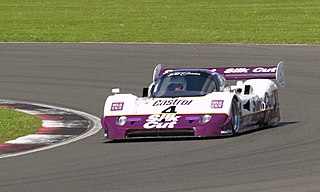
The Jaguar XJR-11 was a sports-prototype racing car introduced for the 1989 World Sports Prototype Championship, while its sister car the XJR-10 was introduced to compete in IMSA series races.

The Nissan NPT-90 was a racing car developed in 1990 for Nissan Motors by Nissan Performance Technology Incorporated (NPTI), formerly known as Electramotive Engineering. It was a replacement for the highly successful GTP ZX-Turbo that had won the IMSA GT Championship in 1989. The NPT-90 would go on to win the championship in 1990 and 1991 before being retired by Nissan at the end of the 1992 season.

The Jaguar XJR-12 is a sports-prototype race car built by the Jaguar Cars-backed Tom Walkinshaw Racing team for both Group C and IMSA Camel GTP. The XJR-12 is famous for winning the 1990 24 Hours of Le Mans race.
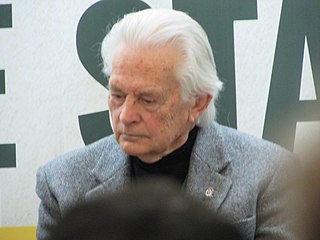
Tony Southgate is an English engineer and former racing car designer. He designed many successful cars, including Jaguar's Le Mans-winning XJR-9, and cars for almost every type of circuit racing. He was responsible for the chassis design of Ford's RS200 Group B rally car. Southgate was employed as chief designer or technical director for many Formula One teams for over twenty years. These teams included BRM, Shadow and Arrows. Southgate retired after producing the Audi R8C, which was a major influence in the Bentley Speed 8, which won Le Mans in 2003. He continues to be a regular visitor to current and historic race meetings.
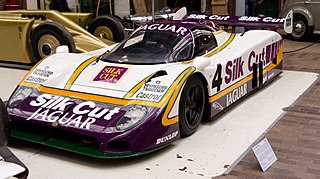
The XJR-8 was a race car built by Jaguar for campaigning in the World Sportscar Championship and the 24 Hours of Le Mans as part of Group C. It was used during the 1987 season.
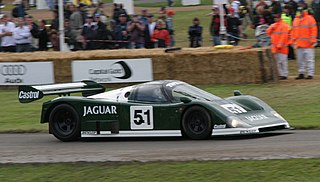
The Jaguar XJR-6 is a Group C sports prototype race car, designed, developed and built by TWR, with the aim of competing, from 1985, in the World Sportscar Championship. A total of six Jaguar XJR-6s were built and they contested in the World Sportscar Championship until 1986, before Jaguar replaced them with the Jaguar XJR-8.

The Eagle MkIII is a sports prototype racing car built by All American Racers in 1991 to IMSA GTP specifications. Powered by a turbocharged Toyota inline-4 engine, the car was campaigned in the IMSA Camel GT series by Dan Gurney's Toyota-sponsored AAR team from 1991 through to the end of 1993. The Eagle MkIII won 21 out of the 27 races in which it was entered and is considered one of the most successful and technologically advanced designs of the IMSA GTP era — "a car that proved so overwhelmingly dominant that the class for which it was created has now been assigned to history", according to Racer magazine.

The Jaguar XJR-10 is an IMSA GTP sports prototype race car, designed, developed, and built by TWR for Jaguar, with the aim of competing, from 1989, in the IMSA GT Championship. Jaguar XJR-10s competed until 1991, before Jaguar replaced it with the Jaguar XJR-16. The car debuted a new 3.0-liter twin-turbo V6 engine, which replaced the previous V12, and was later fitted to the Jaguar XJ220 as well.
The Jaguar XJR-17 was an IMSA Lights racing car, built by Tom Walkinshaw Racing. Rebuilt from a Jaguar XJR-16 for the IMSA Camel Lights, the XJR-17 never competed in the event due to funding issues and has since only been used in a few minor British events and historic races. It used a modified version of the XJR-16's 3.5-litre V6 engine, stripped of the twin-turbochargers and producing a claimed output of 450 hp, whilst its bodywork was cobbled together using various parts from older Jaguar XJR Sportscars.
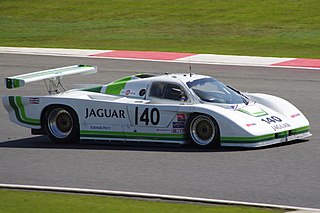
The Jaguar XJR-5 is a IMSA GTP sports prototype race car, designed, developed and built by Group 44 racing for Jaguar with the aim of competing, from 1982, in the IMSA GT Championship. Jaguar XJR-5s contested until 1985, before Jaguar replaced it with the Jaguar XJR-7.





















